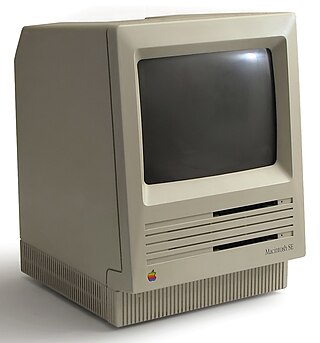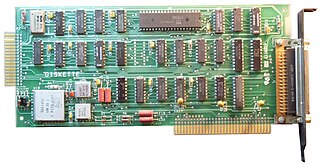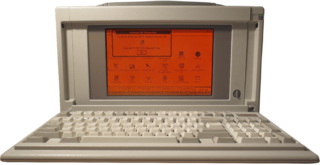
The Tandy 1000 is the first in a line of IBM PC compatible home computer systems produced by the Tandy Corporation for sale in its Radio Shack and Radio Shack Computer Center chains of stores. Introduced in 1984, the product line was aimed at providing affordable but capable systems for home computing or education, with some of its Tandy specific features like graphics, sound and joystick port making it more appealing for home use.

The Macintosh Plus computer is the third model in the Macintosh line, introduced on January 16, 1986, two years after the original Macintosh and a little more than a year after the Macintosh 512K, with a price tag of US$2,599. As an evolutionary improvement over the 512K, it shipped with 1 MB of RAM standard, expandable to 4 MB, and an external SCSI peripheral bus, among smaller improvements. Originally, the computer's case was the same beige color as the original Macintosh, Pantone 453; however, in 1987, the case color was changed to the long-lived, warm gray "Platinum" color. It is the earliest Macintosh model able to run System Software 5, System 6, and System 7, up to System 7.5.5, but not System 7.5.2.

The Personal System/2 or PS/2 is IBM's second generation of personal computers. Released in 1987, it officially replaced the IBM PC, XT, AT, and PC Convertible in IBM's lineup. Many of the PS/2's innovations, such as the 16550 UART, 1440 KB 3.5-inch floppy disk format, 72-pin SIMMs, the PS/2 port, and the VGA video standard, went on to become standards in the broader PC market.

The Apple IIc is a personal computer that was introduced by Apple Inc. shortly after the launch of the original Macintosh. It was a compact and portable version of the Apple II series of computers. The IIc featured a built-in floppy disk drive and a keyboard, and was often sold with its matching monitor. The c in the name stood for compact, referring to the fact it was a complete Apple II computer setup with a floppy drive that was squeezed into a smaller notebook-sized housing. It was compatible with a wide range of software and peripherals.

The IBM PC Convertible is a laptop computer made by IBM, first sold in April 1986. The Convertible was IBM's first laptop-style computer, following the luggable IBM Portable, and introduced the 3½-inch floppy disk format to the IBM product line. Like modern laptops, it featured power management and the ability to run from batteries.

The Macintosh SE is a personal computer designed, manufactured, and sold by Apple Computer, from March 1987 to October 1990. It marked a significant improvement on the Macintosh Plus design and was introduced by Apple at the same time as the Macintosh II.

The Atari Falcon030, released in 1992, is the final personal computer from Atari Corporation. A high-end model of the Atari ST line, the machine is based on a Motorola 68030 CPU and a Motorola 56001 digital signal processor, which distinguishes it from most other microcomputers of the era. It includes a new VIDEL programmable graphics system which greatly improves graphics capabilities.

The Macintosh Classic II is a personal computer designed and manufactured by Apple Computer, Inc. from October 1991 to September 1993. The system has a compact, appliance design with an integrated 9" monitor, typical of the earliest of the Macintosh range. A carrying handle moulded into the case added a degree of portability at a time when laptops were still relatively uncommon.

Compaq's first computers' form factors were portable, also called "luggables", and then "lunchbox computers", and together constituted the Compaq Portable series. These computers measured approximately 16 inches (410 mm) deep, 8 inches (200 mm) tall, and approximately 20 inches (510 mm) wide. As the products evolved, laptops and notebooks were created offing a new level of portability that caused the market to explode.

The Macintosh Quadra 950 is a personal computer designed, manufactured and sold by Apple Computer from March 1992 to October 1995. It replaced the Quadra 900 that was introduced several months earlier, increasing the CPU clock rate of its 68040 CPU from 25 MHz to 33 MHz, and improving the graphics support. The two computers were otherwise identical, including the price. With a Macintosh Processor Upgrade Card installed, this computer is known as the Power Macintosh 950.

A floppy-disk controller (FDC) is a hardware component that directs and controls reading from and writing to a computer's floppy disk drive (FDD). It has evolved from a discrete set of components on one or more circuit boards to a special-purpose integrated circuit or a component thereof. An FDC is responsible for reading data presented from the host computer and converting it to the drive's on-disk format using one of a number of encoding schemes, like FM encoding or MFM encoding, and reading those formats and returning it to its original binary values.

The Atari Mega STE is Atari Corporation's final Motorola 68000-based personal computer in the Atari ST series and the second to last model overall. Released in 1991, the Mega STE is a late-model STE mounted in the case of an Atari TT computer. It was followed by the higher end Atari Falcon in 1992.
The Apple Network Server (ANS) was a line of PowerPC-based server computers designed, manufactured and sold by Apple Computer, Inc. from February 1996 to April 1997. It was codenamed "Shiner" and originally consisted of two models, the Network Server 500/132 and the Network Server 700/150, which got a companion model, the Network Server 700/200 with a faster CPU in November 1996.

The Macintosh Quadra 605 is a personal computer designed, manufactured, and sold by Apple Computer from October 1993 to July 1996. The model names reflect a decision made at Apple in 1993 to follow an emerging industry trend of naming product families for their target customers – Quadra for business, LC for education, and Performa for home. Accordingly, the Performa 475 and 476 was sold in department stores and electronics stores such as Circuit City, whereas the Quadra was purchased through an authorized Apple reseller.
The Commodore PC compatible systems are a range of IBM PC compatible personal computers introduced in 1984 by home computer manufacturer Commodore Business Machines.

The history of laptops describes the efforts, begun in the 1970s, to build small, portable Personal Computers that combine the components, inputs, outputs and capabilities of a Desktop Computer in a small chassis.

The PS/2 E or Energy is a member of the IBM Personal System/2 family of personal computers (PCs). It was the first Energy Star-compliant PC, consuming very little power relative to other contemporary PCs, and made extensive use of recycled materials in its enclosure.

The Compaq Portable 386 is a computer released by Compaq Computer Corporation in 1987. It was equipped with a 20 MHz Intel 80386 CPU, 1 MB RAM, 16 KB ROM, 1.2 MB5¼-inch floppy, 40 or 100 MB hard disk drive, priced at US$7,999 or 9,999 respectively, and a 10" amber gas-plasma display.

The Compaq Portable 486 is a computer released by Compaq Computer Corporation in 1991. It was the last portable computer/"luggable" released under the Compaq Portable series of computers.

The Personal System/2 Model 30 and Personal System/2 Model 30 286 are IBM's entry-level desktop computers in their Personal System/2 (PS/2) family of personal computers. As opposed to higher-end entries in the PS/2 line which use Micro Channel bus architecture, the Model 30 features an Industry Standard Architecture bus, allowing it to use expansion cards from its direct predecessors, the PC/XT and the PC/AT. The original PS/2 Model 30 is built upon the Intel 8086 microprocessor clocked at 8 MHz; the Model 30 286 features the Intel 80286 clocked at 10 MHz.



















